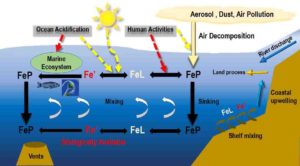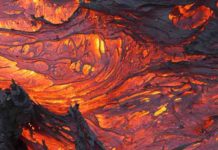
The micronutrient iron (Fe) is recognized as a key factor in controlling oceanic primary productivity, and subsequently impacting the carbon cycle and marine ecosystem. The high-latitude area of the North Pacific is one of the three main high-nutrient and low-chlorophyll (HNLC) regions on Earth. Also, the growth of phytoplankton is limited by the availability of Fe. Climate change, human activities and ocean acidification are expected to influence the availability and transport of Fe in the ocean. Therefore, it is of great importance to study the Fe cycle and make reliable predictions for the future.
“As a result of human activity, the amount and composition of Fe induced by atmospheric decomposition has changed and affected the ocean. After depositing into the ocean, the distribution and transport of Fe is mainly determined by physical processes, e.g., mixing and upwelling. So, clarifying the sources and transport of biologically available Fe are key scientific questions for understanding the marine ecosystem,” explains Dr. Fei Chai, a researcher at the Second Institute of Oceanography and corresponding author of a project report recently published in Atmospheric and Oceanic Science Letters.
“The biological availability of Fe in the ocean also depends on the amount and strength of organic complex ligands. The spatial distribution of Fe-binding ligands is highly variable, with more ligands found in the Northwest Pacific than Northeast Pacific. Also, the strength of ligands is mainly affected by the pH of water, with lower pH reducing the strength of ligands and decreasing the Fe uptake rate of diatoms. Therefore, under the influence of ocean acidification, the distribution and strength of Fe-binding ligands will change considerably, with subsequent impacts on the ecosystem of the North Pacific,” adds Dr. Chai.
Dr. Fei Chai and his team, from the Second Institute of Oceanography, will develop and utilize a coupled physical-biological-Fe model, named ROMS-CoSiNE-Fe, in the North Pacific. The model will incorporate the Fe cycle for the upper North Pacific and make predictions of primary production and marine ecosystems in the future. The project is funded by the National Natural Science Foundation of China from 2018 to 2022.
“These studies will explore the sources and transport of biologically available Fe in the HNLC region. The results can give scientific advice to stakeholders on the feasibility of conducting ocean Fe fertilization,” says Dr. Chai, “In the future, we hope to better understand the rate of Fe uptake by phytoplankton and make predictions of changes in the marine ecosystem of the North Pacific.”
Reference:
Yuntao Wang et al, The sources and transport of iron in the North Pacific and its impact on marine ecosystems, Atmospheric and Oceanic Science Letters (2018). DOI: 10.1080/16742834.2019.1545513
Note: The above post is reprinted from materials provided by Chinese Academy of Sciences.









